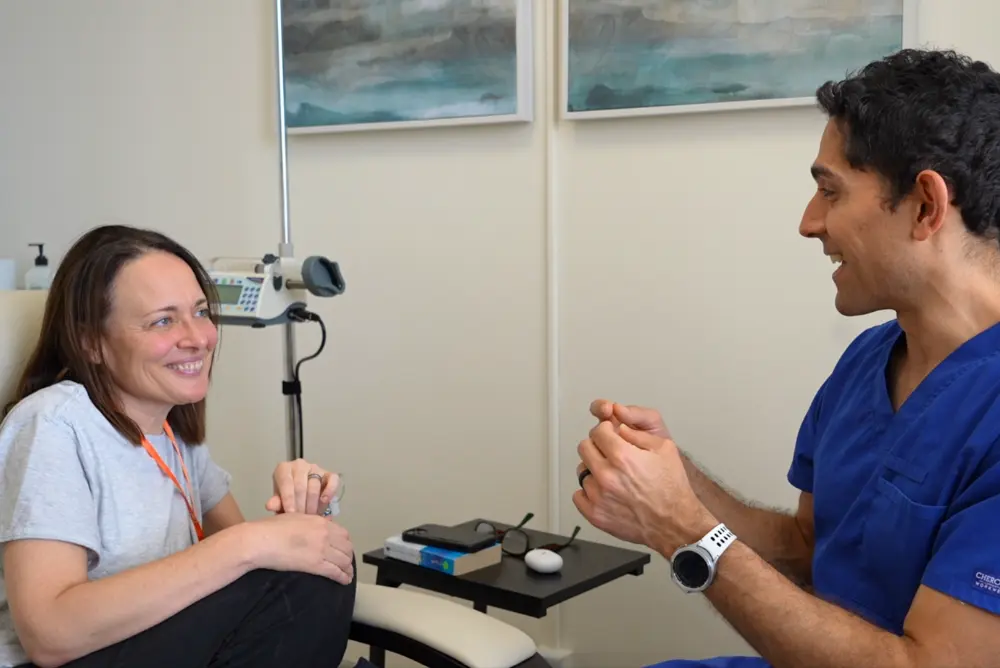PTSD
Explore the potential for rapid and sustained therapies for PTSD that has been resistant to standard treatments
Discover Revolutionary Relief from Anxiety
Clarus Health offers the following therapies with the potential for fast-acting relief from PTSD:
- IV Ketamine
- IV NAD+ and NR
- Stellate Ganglion Block (SGB)
- Genomics testing for individualized treatment plans
These therapies can help fundamentally "re-wire" your brain's windup from PTSD to give you the safest and most effective results. They have decades of clinical, off-label use despite not having FDA approval for the treatment of PTSD.

Stellate Ganglion Block (SGB) & IV Ketamine for PTSD: Treating the Source
Dr. Kaveh’s holistic chronic pain treatment addresses the root causes of PTSD, including both physical and psychological. Sources of PTSD include:
- Childhood trauma, often referred to as adverse childhood experiences (ACE): child abuse (emotional, physical, or sexual), child neglect (emotional or physical), and household dysfunction (domestic violence, substance abuse, mental illness or criminal activity, or parental absence)
- Small to large scale conflicts, such as economic adversity, bullying, school violence, community violence, displacement, and war.
- Combat-related
- Medical illness: after heart attacks, strokes, and intensive care unit (ICU) stays
- Obstructive sleep apnea (OSA): there is significant correlation between OSA and PTSD
Treating PTSD is an Urgent Priority
Untreated PTSD can have serious consequences, including cognitive decline (possibly increasing risk for dementia). When accompanied by depression, the risk of death in increased from cardiovascular disease, diabetes, and suicide.
Given these risks, PTSD must be addressed. Sometimes, however, traditional treatments for PTSD, such as talk therapy and medication, may be ineffective or have intolerable side effects. IV ketamine infusion therapy can be a powerful, safe, and rapid treatment for PTSD.
Dual Sympathetic Reset with Stellate Ganglion Block: a Powerful PTSD Treatment
Your body's fight-flight response is overactivated with PTSD. This leads to a hyperactive nervous system, causing hypervigilance and hyperarousal:
- Hypervigilance refers to being on-guard 24/7
- Hyperarousal is rapid activation of your fight-flight mode, even to non-threatening triggers
There is a bundle of nerves in your body that regulates your sympathetic nervous system that causes the hypervigilance and hyperarousal. That bundle is called the Stellate Ganglion. Numbing (or "blocking") the nerves of the Stellate Ganglion may reduce this hyperreactivity and may give profound symptom relief. An advanced technique of the Stellate Ganglion Block (SGB) is called the Dual Sympathetic Reset (DSR).
DSR blocks 2 levels of your Stellate Ganglion with the potential to provide rapid relief from symptoms of irritability, anxiety, hypervigilance, nightmares, hyperarousal, and other complications of PTSD. You can read more about SGB and DSR here.
Ketamine Breaks Flashback Cycles in PTSD
Flashbacks and vivid nightmares are serious symptoms of PTSD. One reason for these flashbacks is because traumatic experiences prevent the experiences from becoming normal memories. Instead, these memories are vividly relived with sensory overload (hearing, smelling, feeling, etc.).
Ketamine offers the potential to break these cycles of trigger-memory-flashback. Ketamine may do this by reducing the fear response and by inducing neuroplasticity to form new cycles in the brain and body. These new cycles form from new neural connections from the neuroplasticity.
IV Ketamine: Positive Stress vs Toxic Stress
IV Ketamine also fundamentally changes how our nervous system receives information. This includes both physically and psychologically painful signals. This allows for differentiating different stressors, which is critical because not all stresses are traumatic. Ketamine therapy may allow for differentiating different stressors as part of the healing process.
IV Ketamine Infusions for PTSD
Unlike traditional antidepressants and talk therapy, IV Ketamine therapy has the potential to act as quickly as within several hours. Ketamine is particularly effective when PTSD is accompanied by depression and suicidality. Anxiety also affects PTSD severity and has the potential to be improved with Ketamine therapy.
Safety of IV Ketamine for PTSD
IV ketamine therapy for PTSD is very safe with Clarus Health doctors. The side effects of IV ketamine therapy, notably hallucinations and confusion, can be prevented and safely managed with specialized medical supervision. Furthermore, the risks of ketamine therapy are typically significantly less than the risks of other medications or inadequate treatment.
IV ketamine therapy is not meant to be a standalone treatment. It is important to also work with a mental health professional to address the underlying causes of PTSD to produce a sustainable cure.












